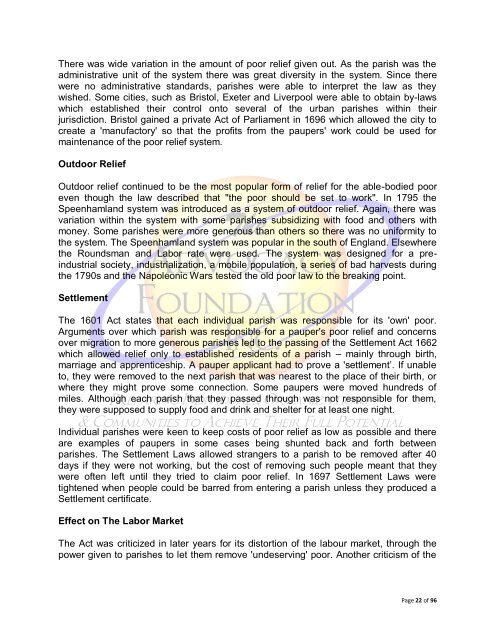Law for The Poor
Law for The Poor
Law for The Poor
You also want an ePaper? Increase the reach of your titles
YUMPU automatically turns print PDFs into web optimized ePapers that Google loves.
<strong>The</strong>re was wide variation in the amount of poor relief given out. As the parish was the<br />
administrative unit of the system there was great diversity in the system. Since there<br />
were no administrative standards, parishes were able to interpret the law as they<br />
wished. Some cities, such as Bristol, Exeter and Liverpool were able to obtain by-laws<br />
which established their control onto several of the urban parishes within their<br />
jurisdiction. Bristol gained a private Act of Parliament in 1696 which allowed the city to<br />
create a 'manufactory' so that the profits from the paupers' work could be used <strong>for</strong><br />
maintenance of the poor relief system.<br />
Outdoor Relief<br />
Outdoor relief continued to be the most popular <strong>for</strong>m of relief <strong>for</strong> the able-bodied poor<br />
even though the law described that "the poor should be set to work". In 1795 the<br />
Speenhamland system was introduced as a system of outdoor relief. Again, there was<br />
variation within the system with some parishes subsidizing with food and others with<br />
money. Some parishes were more generous than others so there was no uni<strong>for</strong>mity to<br />
the system. <strong>The</strong> Speenhamland system was popular in the south of England. Elsewhere<br />
the Roundsman and Labor rate were used. <strong>The</strong> system was designed <strong>for</strong> a preindustrial<br />
society, industrialization, a mobile population, a series of bad harvests during<br />
the 1790s and the Napoleonic Wars tested the old poor law to the breaking point.<br />
Settlement<br />
<strong>The</strong> 1601 Act states that each individual parish was responsible <strong>for</strong> its 'own' poor.<br />
Arguments over which parish was responsible <strong>for</strong> a pauper's poor relief and concerns<br />
over migration to more generous parishes led to the passing of the Settlement Act 1662<br />
which allowed relief only to established residents of a parish – mainly through birth,<br />
marriage and apprenticeship. A pauper applicant had to prove a 'settlement’. If unable<br />
to, they were removed to the next parish that was nearest to the place of their birth, or<br />
where they might prove some connection. Some paupers were moved hundreds of<br />
miles. Although each parish that they passed through was not responsible <strong>for</strong> them,<br />
they were supposed to supply food and drink and shelter <strong>for</strong> at least one night.<br />
Individual parishes were keen to keep costs of poor relief as low as possible and there<br />
are examples of paupers in some cases being shunted back and <strong>for</strong>th between<br />
parishes. <strong>The</strong> Settlement <strong>Law</strong>s allowed strangers to a parish to be removed after 40<br />
days if they were not working, but the cost of removing such people meant that they<br />
were often left until they tried to claim poor relief. In 1697 Settlement <strong>Law</strong>s were<br />
tightened when people could be barred from entering a parish unless they produced a<br />
Settlement certificate.<br />
Effect on <strong>The</strong> Labor Market<br />
<strong>The</strong> Act was criticized in later years <strong>for</strong> its distortion of the labour market, through the<br />
power given to parishes to let them remove 'undeserving' poor. Another criticism of the<br />
Page 22 of 96

















